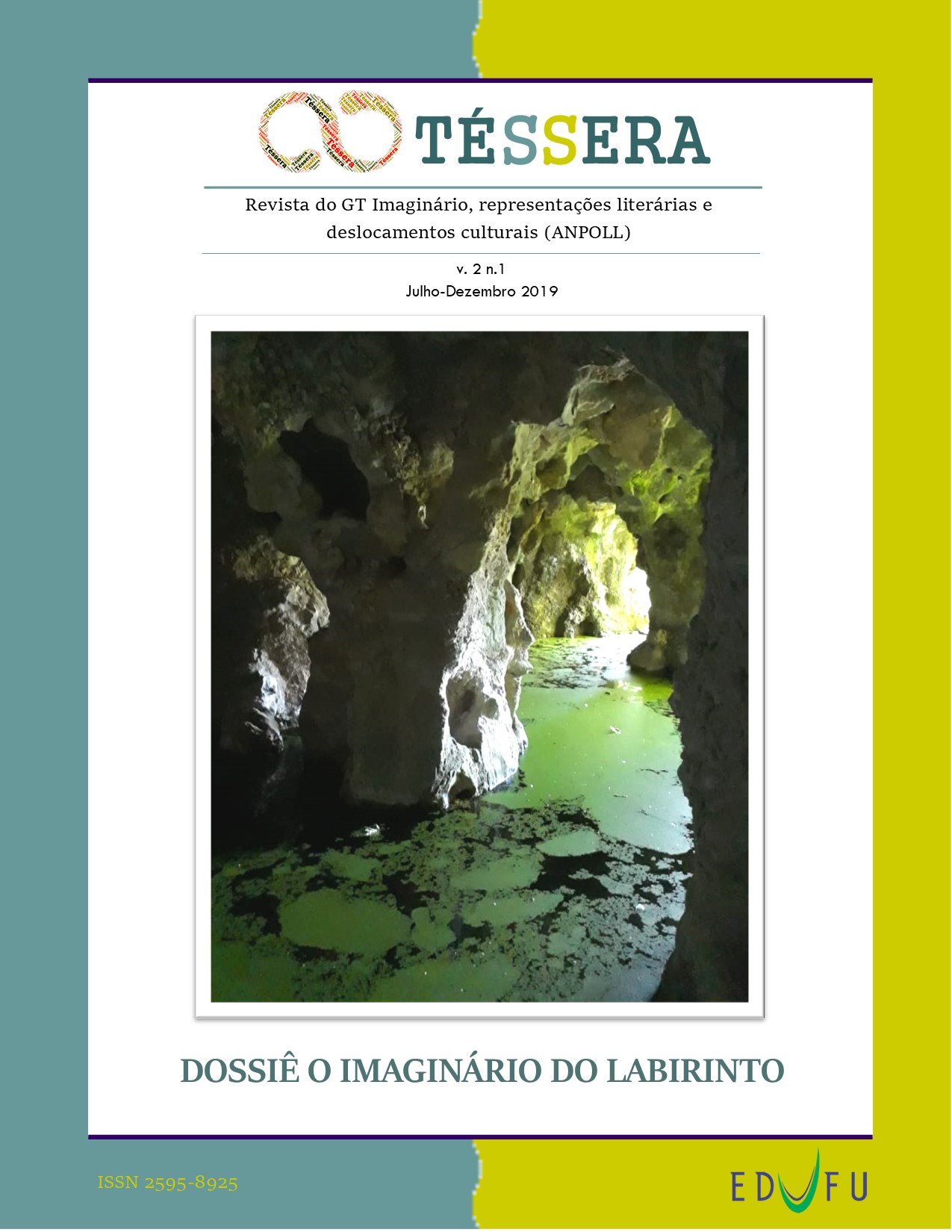BETWEEN VIOLETS AND FLAMES, WINDOWS AND FRAMES
THE DOUBLE IN THE CHARACTER AND SPATIALITIES OF “A DANÇA DO JAGUAR”
DOI:
https://doi.org/10.14393/TES-v2n1-2019-50789Keywords:
Double, Literature, A dança do jaguar, Tereza AlbuesAbstract
The dilemma of identity, in literature, is constantly associated to the myth of double. Besides the usual images of twins and doppelgängers, there may also be a character extrinsic to the original “self”, which generates the exogenous double. Taking into account this idea, this work aims to analyze the forms of double in the novel A dança do jaguar (2000), by Tereza Albues. In Albues’ work, the supernatural is an element that appears in the character through its self’s metamorphoses and developments, which are commons themes in fantastic narrative. Concomitantly, there is a duplication of spatialities, creating the confluence between the domestic space and the pictorial scenario – represented by the screens “Percepção-enigma” and “Asas Felinas” –, which are determined by the structure of the house where the protagonist lives and linked to supernatural events. Considering that fantastic prefers to suspend or reveal the boundaries between matter and spirit; in this novel, the confrontation between self and other acquires different meanings for the characters, such as the search for metaphysical knowledge, which would lead them again to the primordial unity.
Downloads
References
ALBUES, T. A dança do jaguar. Paris: Edição Zero Hora, 2000. 206 p.
ECO, U. Sobre os espelhos. In: ______. Sobre os espelhos e outros ensaios. Trad. Beatriz Borges. Rio de Janeiro: Nova Fronteira, 1989. p. 11-37.
ELIADE, M. Mefistófeles e o andrógino ou o mistério da totalidade. In: ______. Mefistófeles e o andrógino: comportamentos religiosos e valores espirituais não-europeus. Trad. Ivone Castilho Benedetti. 2 ed. São Paulo: Martins Fontes, 1999. p. 77-129.
FOUCAULT, M. Linguagem e literatura. In: MACHADO, Roberto. Foucault, a filosofia e a literatura. Rio de Janeiro: Jorge Zahar, 2000. p.137-174.
FREUD, S. O inquietante. In: ______. História de uma neurose infantil: “O homem dos lobos”: além do princípio do prazer e outros textos (1917-1920). Trad. e notas Paulo César de Souza. São Paulo: Companhia das Letras, 2010. p. 328-376.
FURTADO, F. A construção do fantástico na narrativa. Lisboa: Livros Horizonte, 1980. 151 p.
GAMA-KHALIL, M. M. Espacialidades geradoras da ambientação fantástica em A invenção de Morel. In: BORGES FILHO, O.; BARBOSA, S. (Orgs.). Poéticas do espaço literário. São Paulo: Editora Claraluz, 2009. p. 63-74.
HATTSTEIN, M. Religiões do mundo. Trad. Paula da Silva. Bonner: Könemann, 2000. 120 p.
LINS, O. Lima Barreto e o espaço romanesco. São Paulo: Ática, 1976. 154 p.
PERSONA, L. Tereza Albues: a apaixonada cosmovisão. In: ALBUES, Tereza. Buquê de línguas. Cuiabá: Carlini & Caniato, 2008. 144 p.
POE, E. A. A filosofia da composição. In: ______. Ficção completa, poesia & ensaios. Org. e trad. Oscar Mendes. Rio de Janeiro: Nova Aguiar, 2001. p. 911-920.
PRADA OROPEZA, R. El discurso fantástico contemporáneo: tension semántica y efecto estético. Revista Semiosis. Tercera Época. Xalapa, Veracruz, México: Instituto de Investigaciones Lingüístico-Literarias. v. 2, nº 3, p. 54-76, Enero-Junio/2006.
RAMOS, D. G.; BIASE, M. C. de; BALTHAZAR, M. H. M.; RODRIGUES, M. L. P.; SAUAIA, N. M. L.; SAYEGH, R. R.; MALTA, S. M. T. C. A onça. In: ______. Os animais e a psique. Vol. I. São Paulo: Summus Editorial, 2005. p. 183-219.
ROSSET, C. O real e seu duplo: ensaio sobre a ilusão. Trad. José Thomaz Brum. 2 ed. revista. Rio de Janeiro: José Olympio, 2008. 109 p.
SUZUKI, D.T. Introdução ao zen-budismo. São Paulo: Pensamento, 1969. 157 p.
TODOROV, T. Introdução à literatura fantástica. Trad. de Maria Clara Correa Castello. São Paulo: Perspectiva, 1975. 191 p.
Downloads
Published
How to Cite
Issue
Section
License
Authors who publish in this journal agree to the following terms:
Authors retain the copyright and waiver the journal the right of first publication, with the work simultaneously licensed under the Creative Commons Attribution License (CC BY-NC-ND 4.0), allowing the sharing of work with authorship recognition and preventing its commercial use.
Authors are authorized to take additional contracts separately, for non-exclusive distribution of the version of the work published in this journal (publish in institutional repository or as a book chapter), with acknowledgment of authorship and initial publication in this journal.


